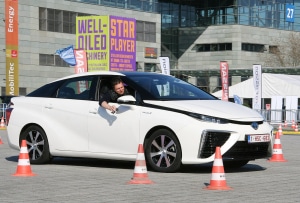Hanover is still the leading sector meeting place for the H2 and FC community. As in previous years, from 13th until 17th April 2015, almost 150 exhibitors presented themselves on the Group Exhibit Hydrogen + Fuel Cells + Batteries in hall 27. Apart from that, however, relatively little was on offer for interested visitors that was worthwhile. The topic of electrical mobility wasn’t as present as it was in previous years. This time, the four large shared stands for Baden-Württemberg, Lower Saxony and North Rhine Westphalia and of the German Solar Mobility Association took center stage at the MobiliTec – and, of course, the Ride & Drive Area, where it was possible to test drive both the Toyota Mirai as well as the VW US Passat HyMotion.
This year, the Hanover trade show site [Hannover Messe] has seen ten flagship trade shows that have attracted more than 220,000 visitors and over 6,500 exhibitors. In 2014 there were some 170,000 visitors at seven flagship trade shows (4,800 exhibitors). While there were some 154 exhibitors exhibiting on over 4.000 m² at the MobiliTec 2014, this year there were only some 120, most of whom were sub-exhibitors on the large shared stands.
The development of infrastructure is experiencing delays
During the press conference at the Group Exhibit for Tobias Renz, and which – now something of a tradition on the first day of the trade show – was also attended by Managing Director of NOW Dr. Klaus Bonhoff and Markus Bachmeier, who is responsible for hydrogen at Linde, the discussions once again concerned the continuation of the National Innovation Program for Hydrogen and Fuel Cell Technology (NIP). Dr. Bonhoff made the case for a new market launch program (see p. 10).
An additional topic was the development of the H2 infrastructure, which isn’t progressing as quickly as hoped for. It is currently conceivable that it won’t be possible to complete the 50 service stations by the end of 2015 that are currently planned because there have been several delays with the specification of the location and the obtaining of construction permits. Right now, 17 H2 stations are complete. Bachmeier explained nonetheless: “Most of them will be ready by the end of 2015.” Bonhoff specified: “There are funding applications and approvals for 50 service stations. The financing is available. If the last ones only go into operation in 2016, then so be it.” The official wording has been changed so that it is now as follows: “An initial strategic development stage will be realized over the remaining term of the NIP – until early 2016.” From the end of 2016 onwards, the company H2Mobility which was founded in March 2015 (which originated from the H2Mobility Initiative) will focus on the development of further hydrogen service stations (400 H2 stations by 2023, see. p. 37).
The fact that things aren’t progressing faster here is also due to the fact that the German auto manufacturers aren’t selling any fuel cell vehicles right now. In comparison with this, Andy Fuchs from Toyota reported that there were around 1,600 signed contracts in Japan in January 2015. The initial production was therefore increased from 700 to 2,000. Next year it is to be 3,000, and in 2020, 10,000 units.


























0 Comments
Trackbacks/Pingbacks